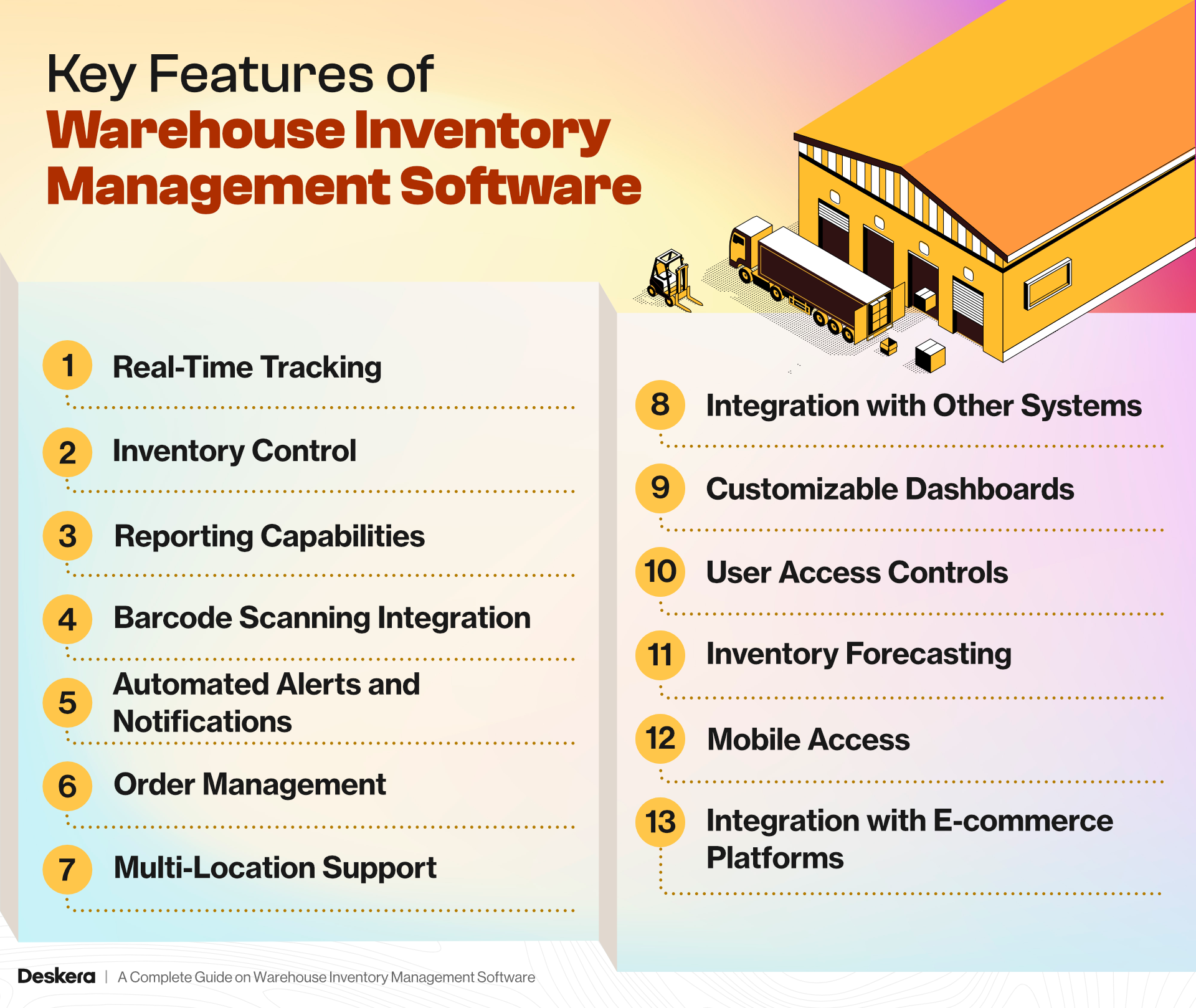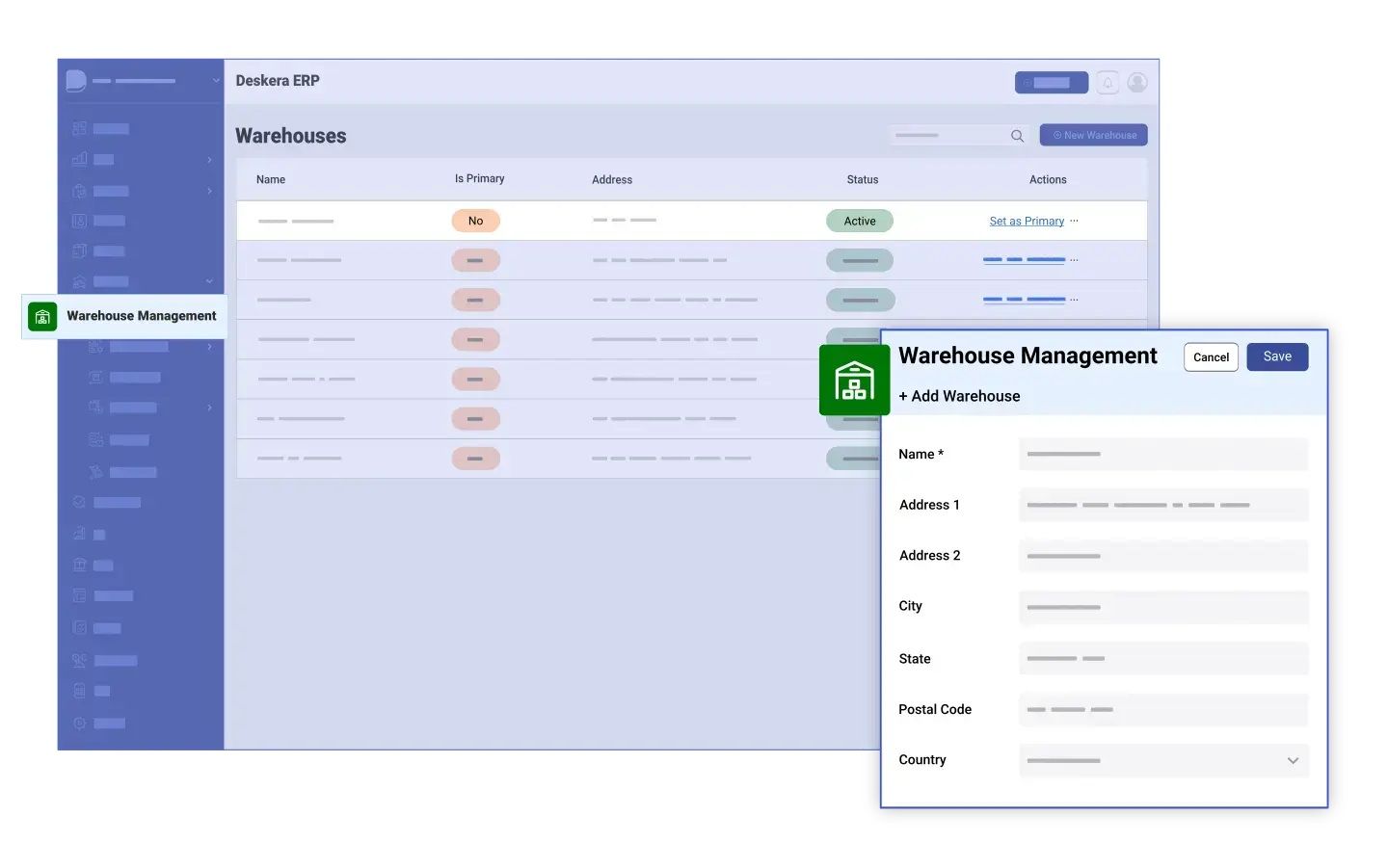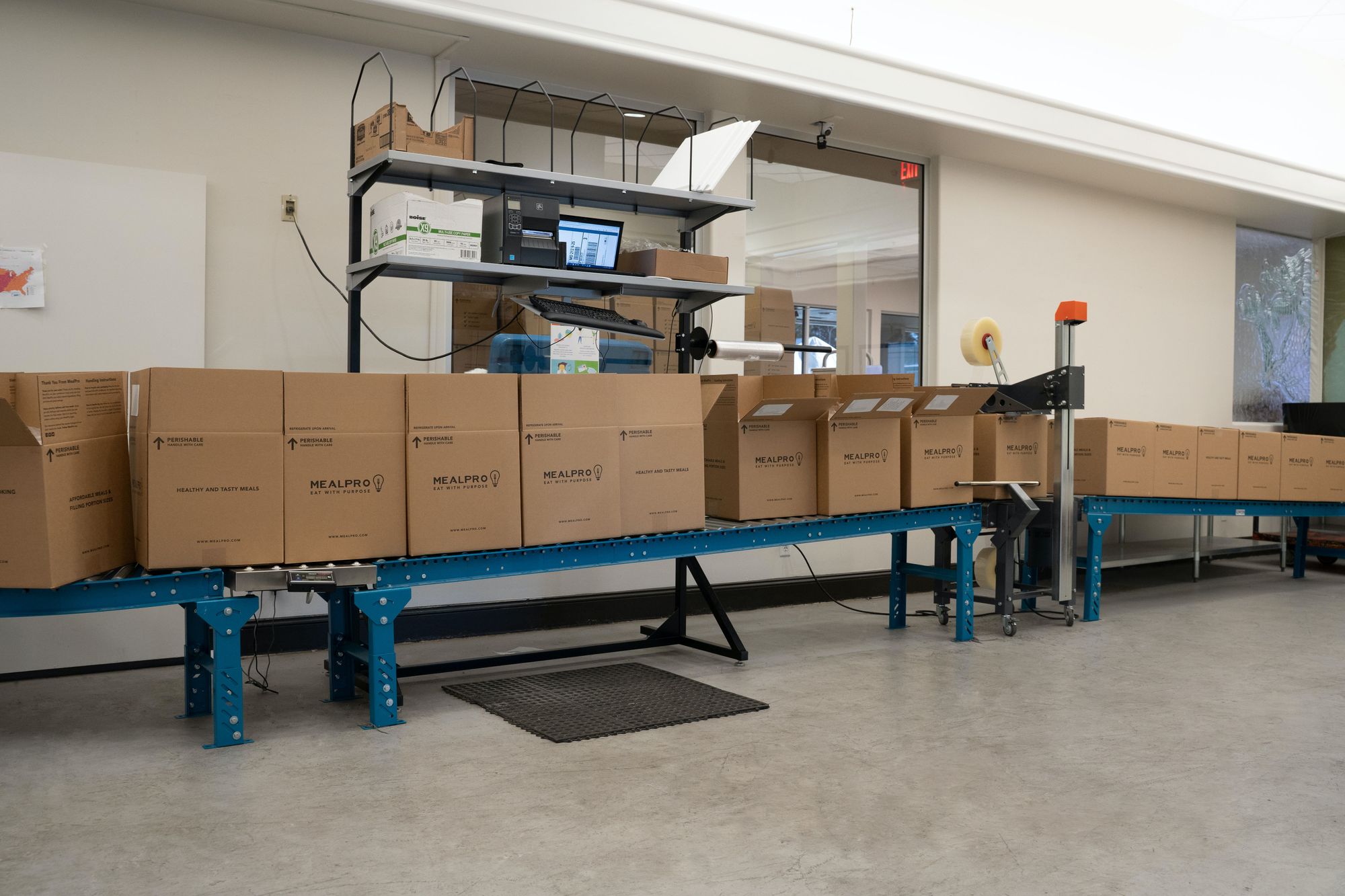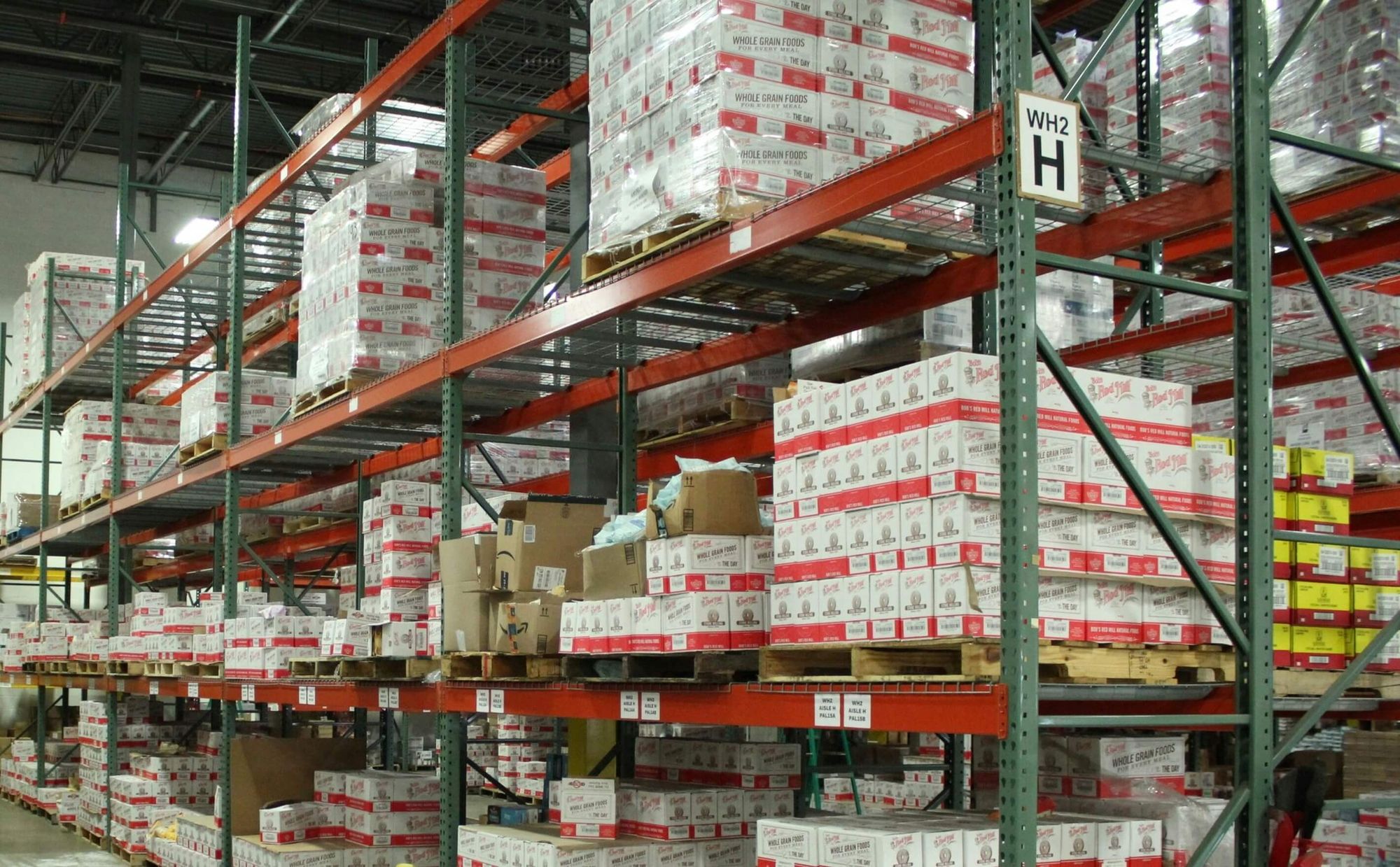Have you ever wondered how large warehouses efficiently manage thousands of products without losing track of inventory? The answer lies in advanced warehouse inventory management systems. In today’s fast-paced business environment, effective warehouse inventory management is essential for maintaining a competitive edge.
It involves overseeing stock levels, optimizing storage, and ensuring timely order fulfillment. Proper management minimizes excess inventory, reduces costs, and enhances customer satisfaction.
Software solutions have transformed warehouse management, taking it from a manual and error-prone process to a streamlined and automated system.
These tools boost efficiency by automating routine tasks, enhance accuracy through real-time tracking, and support better decision-making with comprehensive data analytics. By integrating software into inventory management, businesses can achieve unprecedented levels of control and insight.
One notable example is Deskera ERP, which offers a comprehensive suite of features designed to streamline warehouse operations. Deskera ERP’s inventory management module includes real-time tracking, automated stock updates, and detailed reporting, providing businesses with the tools needed to optimize their warehouse processes and improve overall performance.
What is Warehouse Inventory Management Software?
Warehouse inventory management software is a specialized tool designed to streamline and optimize the management of inventory within a warehouse. This software helps businesses keep track of stock levels, manage product storage, and facilitate order fulfillment with greater efficiency and accuracy.
By automating various aspects of inventory management, this software reduces manual effort and minimizes the risk of errors, ensuring that businesses can maintain optimal inventory levels and respond swiftly to changes in demand.
Key Features of Warehouse Inventory Management Software
A robust warehouse inventory management software solution includes several essential features that enhance its functionality:

Real-Time Tracking
This feature allows businesses to monitor inventory levels and product movements in real time. By providing up-to-date information on stock availability, warehouse inventory software ensures that businesses can make informed decisions and avoid issues such as stock outs or overstocking.
Inventory Control
Effective inventory control is crucial for maintaining the right balance of stock. Warehouse inventory control software helps manage inventory levels, track product locations, and handle inventory adjustments with ease. It also supports processes such as cycle counting and stock reconciliation to ensure accuracy.
Reporting Capabilities
Comprehensive reporting features are a key component of any warehouse inventory management software. These capabilities enable businesses to generate detailed reports on inventory performance, sales trends, and operational efficiency. By analyzing these reports, businesses can identify areas for improvement and make data-driven decisions to optimize their warehouse operations.
Barcode Scanning Integration
Barcode scanning integration is vital for enhancing accuracy and speed in inventory management. By using barcode scanners, warehouse staff can quickly update inventory records, track product movements, and verify items, reducing manual data entry errors and improving operational efficiency.
Automated Alerts and Notifications
Automated alerts and notifications help businesses stay on top of inventory changes and operational issues. This feature can send alerts for low stock levels, order status updates, and other critical events, ensuring that necessary actions are taken promptly.
Order Management
Integrated order management capabilities allow businesses to process and track orders seamlessly. This feature includes functionalities for order creation, fulfillment, and shipping, helping ensure that customer orders are handled efficiently and accurately.
Multi-Location Support
For businesses operating multiple warehouses or locations, multi-location support is essential. This feature enables users to manage inventory across different sites, providing a unified view of stock levels and facilitating centralized control.
Integration with Other Systems
Effective warehouse inventory management software often integrates with other business systems such as ERP (Enterprise Resource Planning) and CRM (Customer Relationship Management) systems. This integration ensures seamless data flow and coordination across various functions, enhancing overall operational efficiency.
Customizable Dashboards
Customizable dashboards provide users with a personalized view of their inventory data. This feature allows businesses to tailor their dashboard to display key metrics, performance indicators, and critical information, enabling quick access to the most relevant data for decision-making.
User Access Controls
User access controls enable businesses to manage permissions and restrict access to sensitive information based on roles and responsibilities. This feature ensures that only authorized personnel can view or modify specific inventory data, enhancing security and compliance.
Inventory Forecasting
Inventory forecasting features use historical data and trends to predict future inventory needs. By anticipating demand fluctuations, businesses can better plan their stock levels, reduce excess inventory, and improve order fulfillment rates.
Mobile Access
Mobile access capabilities allow users to manage inventory on-the-go using smartphones or tablets. This feature is particularly useful for warehouse staff who need real-time access to inventory data and the ability to perform tasks such as scanning and updating inventory from anywhere within the warehouse.
Integration with E-commerce Platforms
For businesses that sell online, integration with e-commerce platforms ensures seamless synchronization of inventory data between the warehouse and online stores. This feature helps manage stock levels across different sales channels and prevent overselling or stock discrepancies.
These features make warehouse inventory management software a crucial tool for modern businesses seeking to enhance their inventory management practices.
Benefits of Using Warehouse Inventory Management Software
Implementing warehouse inventory management software offers a range of benefits that can significantly improve operational efficiency and accuracy.
Here are some of the key advantages:
Increased Efficiency
Warehouse inventory management software automates numerous tasks involved in managing stock, from tracking inventory levels to processing orders.
By reducing the need for manual intervention, it speeds up operations and frees up valuable time for staff to focus on more strategic activities.
This increased efficiency leads to faster order fulfillment and a more streamlined warehouse operation.
Improved Accuracy
One of the most notable benefits of using warehouse inventory software is the enhancement of accuracy in inventory management.
Real-time tracking and automated updates minimize errors associated with manual data entry, ensuring that inventory levels are always accurate.
Features such as barcode scanning integration further boost precision by providing accurate data on product movements and stock levels.
Better Inventory Control
Effective inventory control is critical for maintaining optimal stock levels and preventing issues such as overstocking or stockouts.
Warehouse inventory control software provides businesses with tools to monitor inventory levels, track product locations, and perform regular stock audits.
This helps in maintaining the right balance of inventory, reducing holding costs, and improving overall inventory turnover.
Cost Savings
By optimizing inventory levels and reducing manual processes, warehouse inventory management software helps businesses save on operational costs.
Improved accuracy and efficiency reduce the risk of costly inventory discrepancies and unnecessary stock purchases.
Additionally, enhanced inventory control helps in minimizing carrying costs and improving cash flow.
Enhanced Reporting and Analytics
Comprehensive reporting capabilities are a significant advantage of warehouse inventory management software.
Businesses can generate detailed reports on inventory performance, sales trends, and operational efficiency.
These insights enable better decision-making and help identify areas for improvement, ultimately contributing to more informed strategic planning.
Streamlined Order Management
Integrated order management features within warehouse inventory management software ensure that orders are processed and tracked efficiently.
This includes order creation, fulfillment, and shipping, which helps in meeting customer expectations and improving satisfaction.
Multi-Location Coordination
For businesses with multiple warehouses or storage locations, multi-location support is essential. Warehouse inventory management software allows for centralized control and visibility across various sites, ensuring consistent inventory management and coordination.
Scalability and Flexibility
Modern warehouse inventory management software is designed to scale with business growth. Whether a business is expanding its product range or increasing its warehouse capacity, the software can adapt to new requirements and continue to provide effective inventory management solutions.
Incorporating warehouse inventory management software into your operations not only enhances efficiency and accuracy but also provides valuable tools for better inventory control and cost management.
With features tailored to meet the diverse needs of businesses, this software is a key component of successful warehouse management.
Types of Warehouse Inventory Management Software
When selecting warehouse inventory management software, businesses have several options to consider, each catering to different needs and operational scales. Understanding these types can help in choosing the most suitable solution for your warehouse operations.
Here’s an overview of the main types of warehouse inventory management software:
Basic Warehouse Inventory Software
Ideal for smaller operations or businesses just beginning to digitize their inventory processes, basic warehouse inventory software provides essential functionalities such as inventory tracking, order management, and basic reporting.
While it may not have advanced features, it offers a cost-effective solution for managing inventory effectively and is often user-friendly for those new to inventory management systems.
Advanced Warehouse Inventory Control Software
For businesses with more complex inventory needs, advanced warehouse inventory control software offers a range of sophisticated features. These include real-time tracking, automated stock updates, and integration with other business systems.
Such software is designed to handle large volumes of inventory, provide detailed analytics, and support multi-location management, making it suitable for medium to large enterprises seeking enhanced control and efficiency.
Cloud-Based Warehouse Inventory Management Software
Cloud-based solutions offer the advantage of accessibility from anywhere with an internet connection. This type of warehouse inventory management software allows for real-time updates, centralized data storage, and easy scalability.
Cloud-based systems are often favored for their flexibility, ease of integration with other cloud services, and lower upfront costs compared to on-premises solutions.
On-Premises Warehouse Inventory Management Software
On-premises solutions are installed and operated on a business’s own servers and hardware. This type of software provides greater control over data security and system customization.
On-premises warehouse inventory management software is suitable for businesses with specific compliance requirements or those preferring to manage their IT infrastructure internally.
Open Source Warehouse Inventory Management Software
Open source solutions provide the benefit of customizability and cost savings, as they are often available for free or at a lower cost than proprietary software. These systems allow businesses to modify and tailor the software to their specific needs.
However, they may require more technical expertise to implement and maintain, making them suitable for businesses with IT resources and a need for high levels of customization.
Each type of warehouse inventory management software offers distinct advantages, depending on the size of the business, complexity of inventory needs, and budget considerations.
By understanding these options, businesses can select the software that best aligns with their operational goals and requirements.
Top Warehouse Inventory Management Software Options
When choosing warehouse inventory management software, it's important to consider various solutions available in the market.
Here’s a list of notable software options, including both commercial and open-source solutions, along with a comparison of their features:
1. Deskera ERP

Overview: Deskera ERP is a comprehensive solution that provides robust warehouse management features integrated with its broader ERP functionalities. It is designed to streamline inventory management, enhance operational efficiency, and support data-driven decision-making.
Key Features:
- Real-time tracking of inventory levels and movements
- Automated stock updates and inventory control
- Integrated order management and reporting capabilities
- Barcode scanning integration
- Mobile access for on-the-go management
Strengths:
- User-friendly interface with customizable dashboards
- Affordable pricing, particularly for small to medium-sized businesses
- Comprehensive integration with other business functions such as CRM and finance
Weaknesses:
- Lacks features for document management
2. Oracle NetSuite
Overview: Oracle NetSuite is a leading cloud-based ERP solution with extensive warehouse management capabilities. It is suitable for businesses of all sizes, offering robust features for inventory control, order management, and data analytics.
Key Features:
- Advanced real-time inventory tracking and management
- Multi-location support and global inventory management
- Comprehensive reporting and analytics
- Integration with other Oracle and third-party systems
- Mobile access and barcode scanning
Strengths:
- Highly scalable and suitable for large enterprises
- Extensive customization options and integration capabilities
- Strong analytics and reporting features
Weaknesses:
- Higher cost, which may be prohibitive for small businesses
- Complexity of setup and configuration
To learn more about Deskera ERP vs. NetSuite, click here.
3. Microsoft Dynamics 365
Overview: Microsoft Dynamics 365 offers a suite of integrated business applications, including powerful warehouse inventory management capabilities. It is designed to enhance operational efficiency and improve decision-making across various business functions.
Key Features:
- Real-time inventory tracking and control
- Integration with other Microsoft products and services
- Advanced reporting and analytics
- Multi-location and global inventory management
- Mobile access and barcode scanning
Strengths:
- Seamless integration with Microsoft Office and other Microsoft tools
- Scalable solution suitable for both small and large enterprises
- Robust analytics and AI-driven insights
Weaknesses:
- Can be expensive, especially for smaller businesses
- Complexity may require dedicated IT resources for implementation
To learn more about Deskera ERP vs. Microsoft Dynamics 365, click here.
4. Epicor
Overview: Epicor provides a flexible ERP solution with strong warehouse management features. It is designed for manufacturing and distribution companies, offering comprehensive tools for inventory management, order processing, and supply chain management.
Key Features:
- Real-time inventory tracking and automated replenishment
- Advanced order management and fulfillment capabilities
- Multi-location support and inventory control
- Customizable dashboards and reporting tools
- Integration with other Epicor modules and third-party systems
Strengths:
- Flexible and customizable to meet specific industry needs
- Strong support for manufacturing and distribution environments
- Comprehensive integration options
Weaknesses:
- May require significant customization and setup time
- Higher cost for small to mid-sized businesses
To learn more about Deskera ERP vs. Epicor, click here.
5. Infor
Overview: Infor offers a range of ERP solutions with robust warehouse management features. It is designed to help businesses optimize their inventory processes, improve accuracy, and enhance operational efficiency.
Key Features:
- Real-time inventory tracking and management
- Integration with Infor’s suite of applications and other third-party systems
- Advanced reporting and analytics
- Multi-location and global inventory support
- Barcode scanning and mobile access
Strengths:
- Strong analytics and business intelligence capabilities
- Scalable solutions for various business sizes and industries
- Customizable to fit specific business requirements
Weaknesses:
- Can be complex and require extensive implementation time
- Higher cost associated with advanced features
To learn more about Deskera ERP vs. Infor, click here.
6. SAP Business One
Overview: SAP Business One is an ERP solution tailored for small and medium-sized enterprises (SMEs). It offers comprehensive warehouse management capabilities as part of its broader ERP suite, focusing on improving inventory control and operational efficiency.
Key Features:
- Real-time inventory tracking and control
- Integration with other SAP modules and third-party systems
- Detailed reporting and analytics
- Multi-location support and order management
- Mobile access and barcode scanning
Strengths:
- Scalable and suitable for SMEs with growth potential
- Comprehensive integration with other SAP products
- Strong reporting and analytics features
Weaknesses:
- May be less suitable for very large enterprises with complex needs
- Can be costly compared to other solutions for SMEs
To learn more about Deskera ERP vs. SAP Business One, click here.
Warehouse Inventory Management Software for Small Business
For small businesses, selecting the right warehouse inventory management software involves balancing cost, ease of use, and essential features. Here are some top software options particularly suited for small businesses, along with a discussion on their scalability:
Deskera ERP
- Overview: Deskera ERP offers a comprehensive suite of tools that include warehouse inventory management, CRM, and financial management. It's designed to be user-friendly and affordable, making it a great choice for small businesses.
- Key Features: Real-time inventory tracking, automated stock updates, barcode scanning, and integrated order management.
- Strengths: Easy to use, cost-effective, and integrates well with other business functions. It provides a broad range of features without overwhelming complexity.
- Scalability: Deskera ERP is scalable, allowing businesses to add features and modules as they grow, making it a good option for future expansion.
Katana
- Overview: Katana is designed for small manufacturers and product-based businesses, offering an intuitive interface and powerful inventory management capabilities.
- Key Features: Real-time inventory updates, production planning, order management, and barcode scanning.
- Strengths: Highly visual and easy to navigate, ideal for businesses that need straightforward, efficient inventory and production management.
- Scalability: Katana scales well with business growth, offering additional features and integrations as needed.
To learn more about Deskera ERP vs. Katana, click here.
Acumatica
- Overview: Acumatica provides a cloud-based ERP solution that includes warehouse inventory management, financials, and CRM. It is known for its flexibility and scalability.
- Key Features: Real-time inventory tracking, automated replenishment, multi-location support, and advanced reporting.
- Strengths: Comprehensive features and strong integration capabilities, with a flexible pricing model based on usage rather than user count.
- Scalability: Acumatica is highly scalable, suitable for growing businesses with increasing needs for advanced features and larger operations.
To learn more about Deskera ERP vs. Acumatica, click here.
Odoo
- Overview: Odoo is an open-source ERP system that offers extensive functionality, including warehouse inventory management. It is known for its modular approach, allowing businesses to add modules as needed.
- Key Features: Inventory management, order fulfillment, barcode scanning, and customizable reporting.
- Strengths: Affordable and highly customizable with a large community of developers. Suitable for businesses looking for a flexible and cost-effective solution.
- Scalability: Odoo's modular design allows businesses to start with basic features and scale up by adding more modules and advanced functionalities as they grow.
To learn more about Deskera ERP vs. Odoo, click here.
Fishbowl
- Overview: Fishbowl is a warehouse inventory management solution that integrates with QuickBooks and offers robust features tailored to small and mid-sized businesses.
- Key Features: Real-time inventory tracking, order management, barcode scanning, and reporting.
- Strengths: Strong integration with QuickBooks, user-friendly interface, and comprehensive inventory management features.
- Scalability: Fishbowl can scale with business growth, offering additional features and integrations to support expanding operations.
To learn more about Deskera ERP vs. Fishbowl, click here.
How to Choose the Best Warehouse Inventory Management Software
Choosing the best warehouse inventory management software for your business requires careful consideration of several factors to ensure that the solution meets your specific needs and supports your operational goals. Here’s a step-by-step guide to help you select the most suitable software:
1. Assess Your Business Needs
- Inventory Size and Complexity: Determine the scale of your inventory and its complexity. Consider whether you need basic tracking for a small inventory or advanced features for a large and diverse stock.
- Operational Requirements: Identify specific needs such as multi-location support, real-time tracking, or integration with other business systems (e.g., ERP, CRM).
- User Requirements: Evaluate the needs of your team, including the number of users and their roles. Ensure the software supports different user access levels and permissions.
2. Define Key Features
- Real-Time Tracking: Ensure the software provides real-time visibility into inventory levels and product movements.
- Inventory Control: Look for features that help manage stock levels, track product locations, and handle inventory adjustments.
- Reporting Capabilities: Check for comprehensive reporting and analytics tools to monitor inventory performance and make data-driven decisions.
- Barcode Scanning Integration: Consider software that integrates with barcode scanners to improve accuracy and efficiency.
- Order Management: Ensure the solution includes functionalities for order creation, fulfillment, and tracking.
3. Evaluate Ease of Use
- User Interface: Choose software with an intuitive and user-friendly interface to minimize the learning curve for your team.
- Training and Support: Assess the availability of training resources and customer support. Good support can help with onboarding and resolving issues efficiently.
4. Consider Integration Capabilities
- System Integration: Ensure the software can integrate with other systems you use, such as ERP, CRM, and accounting software. Seamless integration improves data flow and operational efficiency.
- API Availability: Check if the software offers APIs for custom integrations or if it supports integration with popular third-party applications.
5. Evaluate Scalability
- Future Growth: Choose software that can scale with your business. Consider whether it allows for adding more features, users, or locations as your business grows.
- Modular Options: Some software offers modular designs, allowing you to start with basic features and add more functionalities as needed.
6. Review Pricing and Cost
- Cost Structure: Understand the pricing model of the software. This may include one-time licensing fees, subscription-based pricing, or tiered pricing based on features or usage.
- Additional Costs: Consider any additional costs for implementation, training, support, or upgrades.
7. Check Vendor Reputation and Reviews
- Vendor Reputation: Research the vendor’s reputation, reliability, and track record in the industry. Look for testimonials and case studies from similar businesses.
- User Reviews: Read reviews and ratings from other users to gain insights into the software’s performance, strengths, and potential issues.
8. Request Demos and Trials
- Software Demos: Request demos to see the software in action and evaluate its functionalities in a real-world context.
- Free Trials: Take advantage of free trials to test the software’s features and ensure it meets your requirements before committing to a purchase.
9. Consider Customization Options
- Customization: Evaluate whether the software allows for customization to fit your specific business processes and requirements.
- Flexibility: Ensure the solution can be adapted to changes in your business needs over time.
By following these steps, you can make an informed decision and choose the best warehouse inventory management software that aligns with your business needs, supports your operational goals, and enhances overall efficiency.
Key Takeaways
Selecting the right warehouse inventory management software is a critical decision that can significantly impact a business's operational efficiency and scalability.
Taking the time to thoroughly assess and test your options will ensure you invest in a tool that not only meets your current requirements but also grows with your business.
Understanding Warehouse Inventory Management Software:
- Warehouse inventory management software is crucial for modern business operations, enhancing efficiency, accuracy, and decision-making.
- Essential features include real-time tracking, inventory control, reporting capabilities, barcode scanning integration, automated alerts, order management, multi-location support, and system integration.
Popular Software Options:
- Deskera ERP: Offers comprehensive features with an affordable price point, suitable for small to medium-sized businesses. Scalable with additional modules and strong integration capabilities.
- Oracle NetSuite: Provides advanced features and strong analytics, ideal for large enterprises. Offers extensive customization but at a higher cost.
- Microsoft Dynamics 365: Integrates seamlessly with other Microsoft tools, scalable and suitable for both small and large enterprises, though it can be complex and costly.
- Epicor: Flexible and customizable, designed for manufacturing and distribution companies. Suitable for complex needs with a higher cost.
- Infor: Strong analytics and business intelligence capabilities, scalable and customizable for various business sizes.
- SAP Business One: Tailored for SMEs, offering comprehensive integration with other SAP products and strong reporting features.
Best Solutions for Small Businesses:
- Deskera ERP: User-friendly, cost-effective, and scalable.
- Katana: Ideal for small manufacturers with a highly visual and intuitive interface.
- Acumatica: Flexible and scalable with a cloud-based architecture.
- Odoo: Affordable and customizable with a modular design.
- Fishbowl: Integrates well with QuickBooks, user-friendly, and scalable.
Choosing the Best Software:
- Assess Business Needs: Evaluate inventory size, operational requirements, and user needs.
- Define Key Features: Real-time tracking, inventory control, reporting, barcode scanning, and order management.
- Evaluate Ease of Use: User interface, training, and support.
- Consider Integration Capabilities: System integration and API availability.
- Evaluate Scalability: Future growth potential and modular options.
- Review Pricing and Cost: Understand pricing models and additional costs.
- Check Vendor Reputation and Reviews: Research vendor reliability and user feedback.
- Request Demos and Trials: Test the software before committing.
- Consider Customization Options: Ensure flexibility and adaptability.
Related Articles












